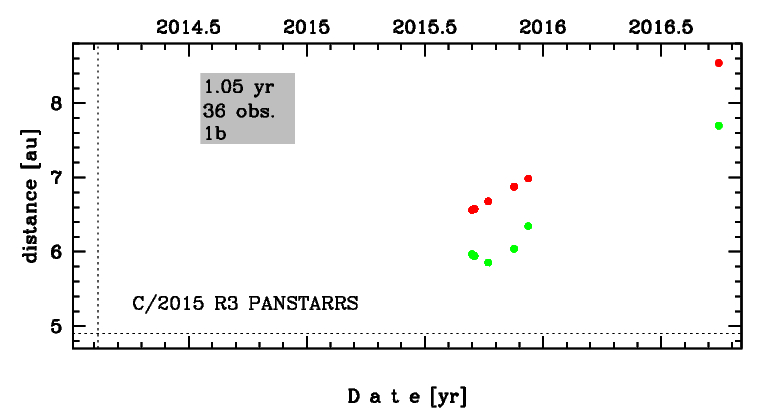C/2015 R3 PANSTARRS
more info
Comet C/2015 R3 was discovered on 12 September 2015 with Pan-STARRS 1 telescope (Haleakala), that is about 1.6 yr after its perihelion passage. After some time pre-discovery data were found going back to 5 March 2013. This comet was rarely observed until 28 September 2016.
Comet had its closest approach to the Earth on 8 May 2015 (4.939 au), a week after its perihelion passage.
We recommended GR solution spanning over 3.57 yr in a range of heliocentric distances from 5.57 au – 4.90 au (perihelion) – 8.54 au as the preferred orbit( solution 'b1'), because radial component of NG~acceleration is negative in solution 'bc'.
This Oort spike comet suffers small planetary perturbations during its passage through the planetary system that lead to a more tight future orbit with a semimajor axis larger than 10000 au (see future barycentric orbits).
Comet had its closest approach to the Earth on 8 May 2015 (4.939 au), a week after its perihelion passage.
We recommended GR solution spanning over 3.57 yr in a range of heliocentric distances from 5.57 au – 4.90 au (perihelion) – 8.54 au as the preferred orbit( solution 'b1'), because radial component of NG~acceleration is negative in solution 'bc'.
This Oort spike comet suffers small planetary perturbations during its passage through the planetary system that lead to a more tight future orbit with a semimajor axis larger than 10000 au (see future barycentric orbits).
| solution description | ||
|---|---|---|
| number of observations | 36 | |
| data interval | 2015 09 12 – 2016 09 28 | |
| data arc selection | data generally limited to post-perihelion (POS) | |
| range of heliocentric distances | 6.56 au – 8.54au | |
| detectability of NG effects in the comet's motion | comet with determinable NG~orbit | |
| type of model of motion | GR - gravitational orbit | |
| data weighting | YES | |
| number of residuals | 65 | |
| RMS [arcseconds] | 0.46 | |
| orbit quality class | 1b | |
| previous orbit statistics, both Galactic and stellar perturbations were taken into account | ||
|---|---|---|
| no. of returning VCs in the swarm | 5001 | * |
| no. of escaping VCs in the swarm | 0 | |
| no. of hyperbolas among escaping VCs in the swarm | 0 | |
| previous reciprocal semi-major axis [10-6 au-1] | 77.20 – 91.68 – 106.48 | |
| previous perihelion distance [au] | 5.12 – 5.3 – 5.76 | |
| previous aphelion distance [103 au] | 19 – 22 – 26 | |
| time interval to previous perihelion [Myr] | 0.91 – 1.1 – 1.5 | |
| percentage of VCs with qprev < 10 | 100 | |
| previous_g orbit statistics, here only the Galactic tide has been included | ||
|---|---|---|
| no. of returning VCs in the swarm | 5001 | * |
| no. of escaping VCs in the swarm | 0 | |
| no. of hyperbolas among escaping VCs in the swarm | 0 | |
| previous reciprocal semi-major axis [10-6 au-1] | 77.20 – 91.67 – 106.48 | |
| previous perihelion distance [au] | 5.12 – 5.27 – 5.58 | |
| previous aphelion distance [103 au] | 19 – 22 – 26 | |
| time interval to previous perihelion [Myr] | 0.91 – 1.1 – 1.5 | |
| percentage of VCs with qprev < 10 | 100 | |
